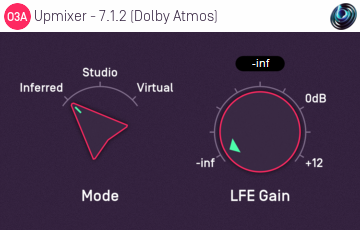O3A Upmixer - 7.1.2 (Dolby Atmos)

Host Support
| Host Type | Support |
|---|---|
| AAX | Yes |
| VST2 | Yes |
Audio
| Channels | Content | |
|---|---|---|
| Input | 10 | 7.1.2 (Dolby Atmos) |
| Output | 16 | O3A |
Controls
Description
This plugin takes a surround mix prepared for a 7.1.2 system and converts it to third order ambisonics (O3A).
7.1.2 is a standard mix format for beds in Dolby Atmos. It adds two ceiling channels to standard 7.1. Please note that this plugin does not process Dolby Atmos bitstreams directly.
Channels
The channel ordering used is:
| Channel | AAX | VST |
|---|---|---|
| 1 | Front Left | Front Left |
| 2 | Front Centre | Front Right |
| 3 | Front Right | Front Centre |
| 4 | Left Surround Side | LFE |
| 5 | Right Surround Side | Left Surround Rear |
| 6 | Left Surround Rear | Right Surround Rear |
| 7 | Right Surround Rear | Left Surround Side |
| 8 | LFE | Right Surround Side |
| 9 | Left Top Surround | Left Top Surround |
| 10 | Right Top Surround | Right Top Surround |
Please note that the channel ordering used by Dolby's Atmos RMU may differ. Also, the AAX order above is used when plugins interact with ProTools through the AAX software interface; other parts of ProTools may use a different default order, for instance when exporting to file.
The plugin is available in the O3A Upmixers plugin library.
Controls
Control: Mode
Three modes are supported, "Inferred", "Studio" and "Virtual". Generally, "Inferred" or "Studio" are recommended.
| Mode | Description |
|---|---|
| Inferred | This mode is optimised for use with material that has been mixed using conventional panning techniques, such as equal-power panning or VBAP. The approach produces smooth transitions when sounds pass between speaker locations. |
| Studio | This mode is optimised for use with material that has been mixed using 'pairwise' panning, for instance in Pro Tool's surround panner. The approach produces smooth transitions when sounds pass between speaker locations. In this mode, the corner layout is always assumed to be Square. |
| Virtual | This mode simply places each of the main (non-LFE) audio channels in their appropriate speaker direction. This can be worth trying when the mix has not been put together by conventional panning and the channels have a complex phase relationship. |
Control: LFE Gain
Audio from the LFE channel can be mixed into the output by setting this dial. It is added to the stream as an omnidirectional signal.
- O3A Injector - First Order
- O3A Injector - N3D
- O3A Mono Ambience
- O3A Stereo Ambience
- O3A Upmixer - 22.2
- O3A Upmixer - 5.1
- O3A Upmixer - 6.1
- O3A Upmixer - 7.1
- O3A Upmixer - 7.1.2 (Dolby Atmos)
- O3A Upmixer - 7.1.4
- O3A Upmixer - Auro-3D 10.1
- O3A Upmixer - Auro-3D 11.1
- O3A Upmixer - Auro-3D 13.1
- O3A Upmixer - Auro-3D 9.1
- O3A Upmixer - Coincident Microphone
- O3A Upmixer - Cube
- O3A Upmixer - IMAX 12.0
- O3A Upmixer - IMAX 5.0
- O3A Upmixer - IMAX 6.0
- O3A Upmixer - Quad
- O3A Upmixer - Stereo
